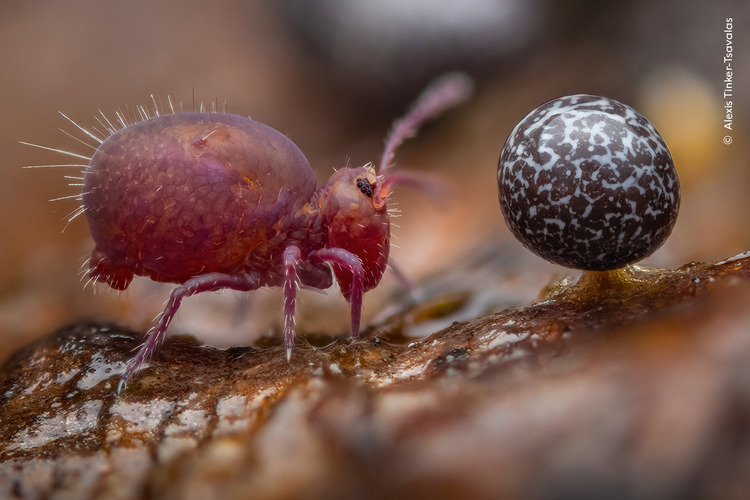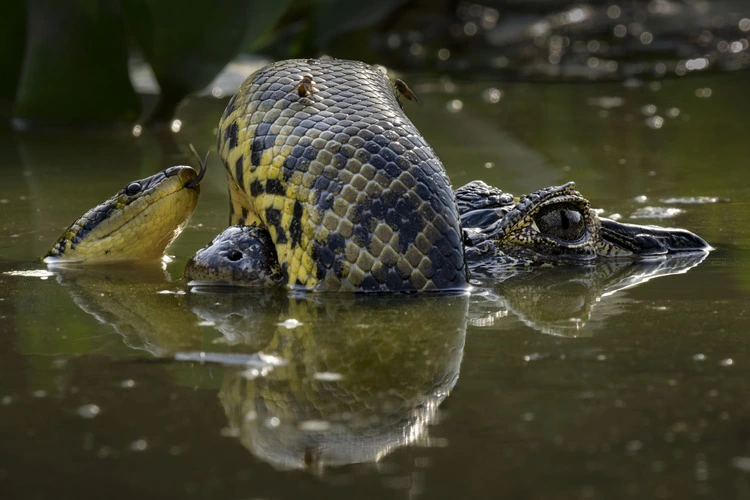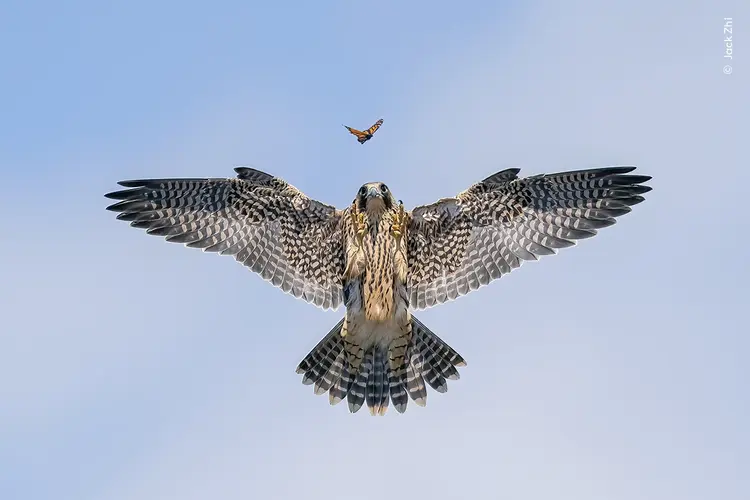 Image: Hikkaduwa Liyanage Prasantha Vinod /Wildlife Photographer of the Year.Discover the winning photographs in the latest Wildlife Photographer of the Year
Image: Hikkaduwa Liyanage Prasantha Vinod /Wildlife Photographer of the Year.Discover the winning photographs in the latest Wildlife Photographer of the YearBy Victoria Heath
Selected from a record-breaking 59,228 entries from 117 countries and territories, the winners of the Natural History Museum’s Wildlife Photographer of the Year competition were announced at an awards ceremony in South Kensington this evening.
The exhibition featuring the 100 awarded images will open on Friday 11 October 2024 at the Natural History Museum, London until Sunday 29 June 2025.
Wildlife Photographer of the Year is developed and produced by the Natural History Museum, London. Discover the overall winners and category winners below, from photographs of pink dolphins in the Amazon to the plastic pollution found in a flesh-footed shearwater.
Wildlife Photographer of the Year 2024 – The Swarm of Life by Shane Gross, Canada Image: Shane Gross/Wildlife Photographer of the Year
Image: Shane Gross/Wildlife Photographer of the YearCanadian Marine Conservation Photojournalist, Shane Gross, was awarded Wildlife Photographer of the Year 2024 for his image ‘The Swarm of Life’, a breathtaking photograph that shines a light on the magical underwater world of western toad tadpoles.
Shane captured the image whilst snorkelling for several hours through carpets of lily pads in Cedar Lake on Vancouver Island, British Columbia, making sure not to disturb the fine layers of silt and algae covering the bottom of the lake. A near threatened species due to habitat destruction and predators, these tadpoles start their transition into toads between four and twelve weeks after hatching, but an estimated 99 per cent of them will not survive to adulthood.
‘The jury was captivated by the mix of light, energy and connectivity between the environment and the tadpoles,’ said Chair of the Jury and Editor, Kathy Moran. ‘We were equally excited by the addition of a new species to the Wildlife Photographer of the Year archive.’
Young Wildlife Photographer of the Year 2024 – Life Under Dead Wood by Alexis Tinker-Tsavalas, Germany Image: Alexis Tinker-Tsavalas/Wildlife Photographer of the Year
Image: Alexis Tinker-Tsavalas/Wildlife Photographer of the YearAlexis Tinker-Tsavalas from Germany was awarded Young Wildlife Photographer of the Year 2024 for his up-close image depicting the fruiting bodies of slime mould on the right and a tiny springtail on the left.
Alexis worked fast to take this photograph, as springtails can jump many times their body length in a split second. He used a technique called focus stacking, where 36 images, each with a different area in focus, are combined.
Springtails are barely two millimetres long (less than a tenth of an inch). They are found alongside slime moulds and leaf litter all over the world. They feed on microorganisms such as bacteria and fungi, improving soil by helping organic matter to decompose.
Enjoying this article? Check out our other wildlife news:Nature’s hidden secrets – new species found in 2024
Shrimp use scent to detect their ‘home’ caves in ocean, study finds
Sloth survival threatened by climate change, study finds
Winner, Photojournalist Story Award – Dolphins of the Forest by Thomas Peschak, Germany/South Africa Image: Thomas Peschak/Wildlife Photographer of the Year
Image: Thomas Peschak/Wildlife Photographer of the YearThomas Peschak documents the relationship between endangered Amazon river dolphins, also known as botos or pink river dolphins, and the people with whom they share their watery home.
The Amazon river dolphin’s relationship with humans is complex. Traditional Amazonian beliefs hold that the dolphins can take on human form, and they are both revered and feared. Others see them as thieves who steal fish from nets and should be killed.
Thomas took these images in areas where local communities are creating opportunities for tourists to encounter the dolphins. This brings another set of problems: when they’re fed by humans, the dolphins become unhealthy and younger individuals don’t learn to hunt for themselves.
Winner, Urban Wildlife – Tiger in Town by Robin Darius Conz, Germany Image: Robin Darius/Wildlife Photographer of the Year
Image: Robin Darius/Wildlife Photographer of the YearRobin Darius Conz watches a tiger on a hillside against the backdrop of a town where forests once grew.
Robin was following this tiger as part of a documentary team filming the wildlife of the Western Ghats. On this day, he used a drone to watch the tiger explore its territory before it settled in this spot.
The protected areas in the Western Ghats, where tigers are carefully monitored, are some of the most biodiverse landscapes in India and have a stable population of tigers. Outside these areas, where development has created conflict between humans and wildlife, tiger occupancy has declined.
Winner, Underwater – Under the Waterline by Matthew Smith, UK/Australia Image: Matthew Smith/Wildlife Photographer of the Year
Image: Matthew Smith/Wildlife Photographer of the YearMatthew Smith carefully photographs a curious leopard seal beneath the Antarctic ice.
Matthew used a specially made extension he designed for the front of his underwater housing to get this split image. It was his first encounter with a leopard seal. The young seal made several close, curious passes. ‘When it looked straight into the lens barrel, I knew I had something good.’
Though leopard seals are widespread and abundant, overfishing, retreating sea ice and warming waters mean that krill and penguins – their main food sources – are both in decline.
Winner, Behaviour: Amphibians and Reptiles – Wetland Wrestle by Karine Aigner, USA Image: Karine Aigner/Wildlife Photographer of the Year
Image: Karine Aigner/Wildlife Photographer of the YearKarine Aigner recognises the skin of a yellow anaconda as it coils itself around the snout of a yacaré caiman.
The tour group Karine was leading had stopped to photograph some marsh deer when she noticed an odd shape floating in the water. Through binoculars, Karine quickly recognised the reptiles and watched as they struggled with each other.
Caimans are generalist feeders and will eat snakes. As anacondas get larger, they will include reptiles in their diet. It’s hard to determine who is the aggressor here. On the snake’s back are two tabanids, blood-sucking horseflies that are known to target reptiles.
Winner, Impact Award – Recording by Hand by Liwia Pawłowska, Poland Image: Liwia Pawlowska/Wildlife Photographer of the Year
Image: Liwia Pawlowska/Wildlife Photographer of the YearLiwia Pawłowska watches as a relaxed common whitethroat is gently held by a bird ringer.
Liwia is fascinated by bird ringing, and has been photographing ringing sessions since she was nine. She says that she hopes her photograph ‘helps others to get to know this topic better.’
Volunteers can assist trained staff at bird-ringing sessions, where a bird’s length, sex, condition and age are recorded. Data collected helps scientists to monitor populations and track migratory patterns, aiding conservation efforts.
Winner, Oceans: The Bigger Picture – A Diet of Deadly Plastic by Justin Gilligan, Australia Image: Justin Gilligan/Wildlife Photographer of the Year
Image: Justin Gilligan/Wildlife Photographer of the YearJustin Gilligan (Australia) creates a mosaic from the 403 pieces of plastic found inside the digestive tract of a dead flesh-footed shearwater.
Justin has been documenting Adrift Lab’s work for several years, often joining them on beach walks at dawn to collect dead chicks. The team brings together biologists from around the world to study the impact of plastic pollution on marine ecosystems.
Studies found that three quarters of adult flesh-footed shearwaters breeding on Lord Howe Island – and 100% of fledglings – contained plastic. The team, including a Natural History Museum scientist, discovered it causes scarring to the lining of the digestive tract, a condition called plasticosis.
Winner, Behaviour: Invertebrates – The Demolition Squad by Ingo Arndt, Germany Image: Ingo Arndt/Wildlife Photographer of the Year
Image: Ingo Arndt/Wildlife Photographer of the YearIngo Arndt documents the efficient dismemberment of a blue ground beetle by red wood ants.
‘Full of ant’ is how Ingo described himself after lying next to the ants’ nest for just a few minutes. Ingo watched as the red wood ants carved an already dead beetle into pieces small enough to fit through the entrance to their nest.
Much of the red wood ants’ nourishment comes from honeydew secreted by aphids, but they also need protein. They are capable of killing insects and other invertebrates much larger than themselves through sheer strength in numbers.
Winner, Animal Portraits – On Watch by John E Marriott, Canada Image: John Marriott/Wildlife Photographer of the Year
Image: John Marriott/Wildlife Photographer of the YearJohn E Marriott frames a lynx resting, with its fully grown young sheltering from the cold wind behind it.
John had been tracking this family group for almost a week, wearing snowshoes and carrying light camera gear to make his way through snowy forests. When fresh tracks led him to the group, he kept his distance to make sure he didn’t disturb them.
Lynx numbers usually reflect the natural population fluctuations of their main prey species, the snowshoe hare. With climate change reducing snow coverage, giving other predators more opportunities to hunt the hares, hare populations may decline, in turn affecting the lynx population.
Winner, Impact Award – Hope for the Ninu by Jannico Kelk, Australia Image: Jannico Kelk/Wildlife Photographer of the Year
Image: Jannico Kelk/Wildlife Photographer of the YearJannico Kelk illuminates a ninu, with the wire grass and shrubs behind it providing a frame against the darkness.
Jannico spent each morning walking the sand dunes of a conservation reserve, searching for footprints that this rabbit-sized marsupial may have left the night before. Finding tracks near a burrow, he set up his camera trap.
The greater bilby has many Aboriginal names, including ninu. It was brought to near extinction through predation by introduced foxes and cats. Within fenced reserves where many predators have been eradicated, the bilby is thriving.
Winner, Behaviour: Birds – Practice Makes Perfect by Jack Zhi, USA Image: Jack Zhi/Wildlife Photographer of the Year
Image: Jack Zhi/Wildlife Photographer of the YearJack Zhi enjoys watching a young falcon practising its hunting skills on a butterfly, above its sea-cliff nest.
Jack has been visiting this area for the past eight years, observing the constant presence of one of the birds and photographing the chicks. On this day it was a challenge to track the action because the birds were so fast.
Should this young peregrine falcon make it to adulthood, tests have shown it will be capable of stooping, or dropping down on its prey from above, at speeds of more than 300 kilometres per hour (186 miles per hour).
Winner, Animals in their Environment – Frontier of the Lynx by Igor Metelskiy, Russia Image: Igor Metelskiy/Wildlife Photographer of the Year
Image: Igor Metelskiy/Wildlife Photographer of the YearIgor Metelskiy shows a lynx stretching in the early evening sunshine, its body mirroring the undulating wilderness.
The remote location and changing weather conditions made access to this spot – and transporting equipment there – a challenge. Igor positioned his camera trap near the footprints of potential prey.
It took more than six months of waiting to achieve this relaxed image of the elusive lynx. A survey carried out in 2013 estimated the entire Russian lynx population was around 22,500 individuals, with numbers for the Russian Far East, including those in Primorsky Krai, at 5,890.
Winner, Behaviour: Mammals – A Tranquil Moment by Hikkaduwa Liyanage Prasantha Vinod, Sri Lanka Image: Hikkaduwa Liyanage Prasantha Vinod /Wildlife Photographer of the Year
Image: Hikkaduwa Liyanage Prasantha Vinod /Wildlife Photographer of the YearHikkaduwa Liyanage Prasantha Vinod finds this serene scene of a young toque macaque sleeping in an adult’s arms.
Resting in a quiet place after a morning of photographing birds and leopards, Vinod soon realised he wasn’t alone. A troop of toque macaques was moving through the trees above. Vinod spotted this young monkey sleeping between feeds and used a telephoto lens to frame the peaceful moment.
Toque macaques easily adapt to human foods, and the encroachment of plantations into their habitat has seen an increase in incidents of shooting, snaring and poisoning by farmers trying to preserve their crops.
The full list of Category Winners for Wildlife Photographer of the Year 2024:Alberto Román Gómez (Spain), Winner of the 10 and Under CategoryParham Pourahmad (USA), Winner of the 11-14 CategoryAlexis Tinker Tsavalas (Germany), Winner of the 15-17 CategoryIgor Metelskiy (Russia), Winner of Animals in Their EnvironmentJohn E Marriott (Canada), Winner of Animal PortraitsJack Zhi (USA), Winner of Behaviour: BirdsHikkaduwa Liyanage Prasantha Vinod (Sri Lanka), Winner of Behaviour: MammalsKarine Aigner (USA), Winner of Behaviour: Amphibians and ReptilesIngo Arndt (Germany), Winner of Behaviour: InvertebratesJustin Gilligan (Australia), Winner of Oceans: The Bigger PictureFortunato Gatto (Italy), Winner of Plants and FungiJiří Hřebíček (Czech Republic), Winner of Natural ArtistryMatthew Smith (UK / Australia), Winner of UnderwaterRobin Darius Conz (Germany), Winner of Urban WildlifeShane Gross (Canada), Winner of Wetlands: The Bigger PictureBritta Jaschinski (UK / Germany), Winner of PhotojournalismThomas Peschak (South Africa / Germany), Winner of the Photojournalist Story AwardSage Ono (USA), Winner of the Rising Star Portfolio AwardRelated articles:Iberian lynx makes remarkable recoveryGlobal effort to save endangered river dolphinsIndochinese tiger population increasesNew footage released of unseen tiger for Global Tiger Day10 endangered species to watch in 2023Filed Under: Briefing, Wildlife Tagged With: Photography
